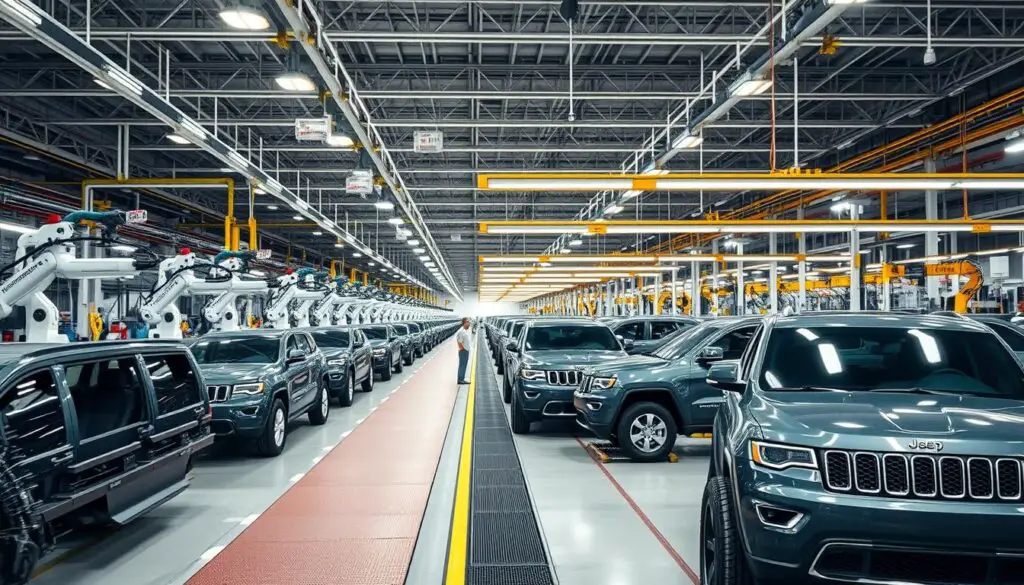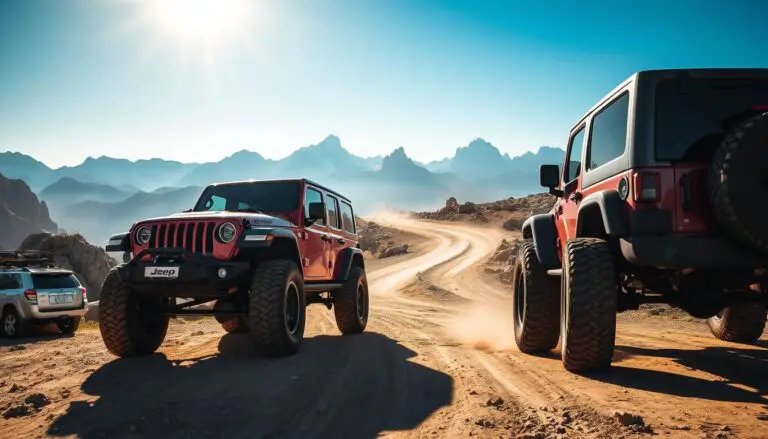This short guide gives a clear answer about assembly and domestic content for the iconic SUV. If you want a direct view of where final assembly happens today, this section sets expectations and explains how final assembly, parts sourcing, and engine locations shape a “made America” claim.
The Grand Cherokee has been built at Jefferson North Assembly Plant in Detroit since 1993. That plant handles final assembly for many versions and shares lines with the Dodge Durango.
Jeep also keeps key U.S. hubs: Toledo, Ohio for Wrangler and Gladiator and Belvidere, Illinois for Cherokee. At the same time, global plants in Melfi, Goiana, Guangzhou, and Ranjangaon support regional demand and special trims.
Engines and transmissions factor heavily into domestic content. Pentastar V‑6 units come from Trenton and Detroit, plus Saltillo, Mexico, which affects overall domestic percentages used by indexes like Cars.com’s American-Made list.
Key Takeaways
- Final assembly: Grand Cherokee is assembled at Jefferson North in Detroit.
- U.S. plants for other models keep manufacturing capacity strong.
- Global factories serve regional markets and some configurations.
- Engine origin and parts sourcing shape any “made America” claim.
- Historical roots and current investments keep U.S. assembly central to the brand.
At a glance: Is the Jeep Grand Cherokee made in the United States today?
Yes. For buyers in the united states, the jeep grand cherokee for the U.S. market is assembled at Detroit’s Jefferson North assembly plant.
That facility has handled final assembly since the model debuted in 1993 and continues that role today. Final assembly location defines “U.S.-built” status, while many parts still come from mixed global suppliers.

Jefferson North also builds the Dodge Durango, showing how shared lines boost production efficiency. Other major models assembled domestically include Wrangler and Gladiator at Toledo and Cherokee at Belvidere, reinforcing Jeep’s broad U.S. presence.
This quick snapshot gives shoppers an immediate answer before they review deeper production and parts sourcing details later in the guide.
Where Jeep Grand Cherokee Made: Are They Produced in the US?
“Jefferson North has been the heart of U.S. assembly for this flagship SUV since 1993.”
Since 1993, Detroit’s Jefferson North has been the core assembly address for this flagship SUV. The facility opened in 1991 and grew with a major expansion in 1999.

Detroit’s Jefferson North Assembly Plant: a long-running home
This assembly plant sits entirely inside Detroit city limits, a rare case among modern auto factories. It handled models such as the Commander and has built this SUV across multiple generations.
How U.S.-spec models are assembled for buyers
Final assembly happens on site while parts arrive from regional and global suppliers. That mix helps control cost and maintain quality for North American production.
Shared lines with Dodge Durango inside Detroit
The facility shares lines with the dodge durango to balance scheduling and capacity. This flexibility lets the team switch between models without major downtime.
“Detroit assembly supports local jobs and boosts domestic-content scores used by independent rankings.”
- Continuity: Jefferson North has built the grand cherokee since launch.
- Significance: It is the only auto factory located fully within Detroit limits.
- Operations: Shared assembly lines keep production flexible for multiple vehicles.
Key U.S. Jeep assembly hubs that shape the lineup
Several U.S. facilities shape how core models reach buyers and support ongoing production across states.
Toledo, Ohio: historic complex and modern output
Toledo Complex is the center for jeep wrangler assembly and builds the jeep gladiator as well.
The site traces back to Willys-Overland wartime work and was rebuilt in 2006 to modernize production. That investment made the plant ready for long-term demand.
Belvidere, Illinois: flexible regional factory
Belvidere has a solid track record assembling the jeep cherokee and earlier models like the Patriot.
The plant shows how U.S. facilities adapt to changing model needs and support regional supply chains.
“Historic roots and recent upgrades keep American plants central to the brand’s manufacturing network.”
| Site | Main models | Notable fact |
|---|---|---|
| Toledo Complex | jeep wrangler, jeep gladiator | Rebuilt 2006; Willys-Overland heritage |
| Belvidere | jeep cherokee, Patriot (past) | Flexible assembly for regional demand |
| Detroit (complement) | Flagship SUV lines | Balances capacity across multiple vehicles |
Why this matters: Shoppers comparing models can see that a distributed network of plants keeps supply steady and supports local jobs across the united states.
Global Jeep manufacturing footprint and what’s built outside America
International plants supply many compact and regional SUVs while U.S. assembly handles flagship lines.
Melfi, Italy
Melfi serves as a key European hub. It assembles the jeep renegade and jeep compass alongside related small models like the Fiat 500X.
Some units from this factory are allocated to north america depending on trim and demand.
Goiana, Brazil
Goiana is a comprehensive complex with stamping, assembly, R&D, a test track, and training facilities.
It builds regional compass and renegade variants and supports localized development for South American markets.
Guangzhou, China
Guangzhou produces market-specific versions of the Cherokee, renegade, and compass for Chinese buyers.
Local features and regulation compliance guide production choices there.
Ranjangaon, India
Ranjangaon focuses on right-hand-drive exports and keeps global quality and process standards for vehicles sent to RHD markets.
“International plants let the brand optimize logistics, respond to demand, and support competitive pricing.”
Context: Brazil now ranks just behind the United States for sales of compass and renegade models, showing diversified demand across global markets.
Parts, engines, and the “American-made” picture
Assessing national content means looking beyond assembly lines to where key components and engines come from.
Pentastar V‑6 origins
Pentastar V‑6 engines are built at Trenton (MI), Mack Avenue in Detroit, and Saltillo South in Mexico. Mixed sourcing helps capacity and keeps quality consistent across production.
Transmissions and label rules
Transmissions and other components influence the percent of U.S./Canadian parts shown on AALA window stickers. That percentage, plus engine origin and final assembly, shapes any “made america” claim.
Index signals and shopper advice
Cars.com’s American‑Made Index weighs assembly location, parts content, engine/transmission origin, and workforce contributions. U.S.-assembled models such as Wrangler, Gladiator, Cherokee, and Grand Cherokee have scored well for those reasons.
“Check the window sticker for the most accurate domestic-content figure for a specific model and trim.”
- Final assembly matters, but parts and powertrain origin matter too.
- Window labels under AALA provide the official parts percentage.
- Strong domestic assembly plus selective global sourcing supports value and availability.
How Jeep’s history and ownership influence today’s production
Roots in wartime vehicle work at Toledo set a practical, go-anywhere ethos that still guides modern SUV design.
From WWII origins, Willys-Overland’s Toledo operations created an American manufacturing identity. Early military contracts proved durable engineering and simple, rugged design that later shaped civilian models.
From Willys to a global company
Ownership shifted several times: Kaiser, AMC (with Renault ties), then Chrysler, DaimlerChrysler, FCA, and now Stellantis. This timeline shows how corporate choices drove investment in plants and supply chains.
Licensed builds and global reach
Early licensed production with partners such as Mitsubishi and Mahindra foreshadowed later international strategy. Those agreements helped test foreign markets and manufacturing methods.
“Historic U.S. hubs like Toledo and Detroit remain anchors even as global capacity supports select regions.”
- Heritage: wartime work set a foundation for durable vehicles.
- Ownership: multiple corporate stewards shaped factory investment.
- Focus: since the 1990s, core nameplates returned to north america for final assembly.
That continuity links the brand’s past to present production choices. Strong U.S. assembly for key models reassures buyers while global plants supply region-specific jeeps and components where it adds value.
Looking ahead: Production context as Jeep electrifies its lineup
As battery vehicles enter the lineup, plant investments and logistics will follow demand signals.
Roadmap and plants: Recon and Wagoneer S are planned for North America and Europe. Those models can drive new tooling and capacity at select production hubs.
Affordable EVs matter too. A teased $25,000 electric Renegade could shift volume allocation toward facilities that can scale high-demand models efficiently.
What this means for manufacturing strategy
- Supply chains: Battery sourcing and local suppliers will shape which facility gains new work.
- Workforce: Upskilling and new assembly lines will be needed for BEV design and testing.
- Regional models: Avenger’s European launch shows the company will tailor where certain vehicles are built to match market rules and incentives.
Stellantis’ Dare Forward 2030 and major electrification spending back long-term plant upgrades and software investments.
Bottom line: Electrification will reshape some plant roles, but strong North American assembly is likely to remain central as the brand balances sales, logistics, and global markets.
Conclusion
Detroit’s Jefferson North remains central to assembly for the flagship SUV. That factory also builds the Dodge Durango and anchors a clear U.S. footprint for the grand cherokee.
Toledo supplies jeep wrangler and jeep gladiator output, while Belvidere supports the jeep cherokee. These plants and a few global sites — Melfi, Goiana, Guangzhou, Ranjangaon — keep production aligned with demand.
Parts and engines still come from mixed sources (Trenton, Detroit, Saltillo), so check the AALA window sticker for exact domestic-content figures before purchase.
Overall, American assembly, historic roots, and Stellantis’ EV plans mean core models and new jeep EVs will remain tightly linked to U.S. factories and workers.
FAQ
Is the Grand Cherokee assembled in the United States today?
Yes. The current Grand Cherokee for the U.S. market is assembled at Stellantis’ Jefferson North Assembly Plant in Detroit, Michigan. That facility has produced the model for decades and handles final assembly, inspection, and local-market configuration.
Do any other U.S. plants build Jeep models that share platforms with the Grand Cherokee?
Yes. The Dodge Durango, which shares major components and a platform with the Grand Cherokee, is built on shared lines at the same Detroit complex. Other U.S. Stellantis hubs—like the Toledo Complex in Ohio—produce Wrangler and Gladiator models that share engineering and parts strategies across the lineup.
Where are Jeep models manufactured outside North America?
Stellantis operates international assembly plants that build Jeep models for regional markets. Notable sites include Melfi, Italy (Compass and Renegade), Goiana, Brazil (regional Compass and Renegade), Guangzhou, China (market-specific Compass, Cherokee, and Renegade), and Ranjangaon, India (right‑hand‑drive exports).
Are engines and transmissions for the Grand Cherokee made in the U.S.?
Many powertrain components come from North American facilities. The Pentastar V‑6 family and some other engines are produced in Michigan and nearby plants, while Stellantis also sources engines and transmissions from Saltillo, Mexico, and other sites. Content percentages vary by model and trim.
How does domestic content affect “American‑made” claims for these SUVs?
Domestic content depends on the assembly location, origin of parts, and where final vehicle completion occurs. Programs like Cars.com’s American‑Made Index and regulations such as the American Automobile Labeling Act measure these factors. Models assembled in U.S. plants with significant U.S./Canadian/Mexican parts generally score higher.
Has production location for this model changed over time?
Yes. Production has shifted with platform updates, facility investments, and corporate changes. The Grand Cherokee has long ties to Detroit and Toledo-area manufacturing, reflecting decades of retooling, model generations, and corporate ownership shifts from AMC to Chrysler, then FCA, and now Stellantis.
Will electric versions affect where future models are built?
Likely. Stellantis has announced electrification plans and investments in North American facilities. Future EV variants may be assigned to plants with battery assembly or EV-capable lines, influencing plant strategy and potentially adding new U.S. production for electric SUVs.
Can buyers verify where a specific vehicle was assembled?
Yes. The vehicle’s door jamb label and the federal VIN decode include the final assembly plant code and country. Dealers can also confirm build location and parts origin for a specific VIN on request.


